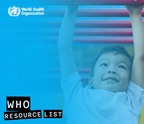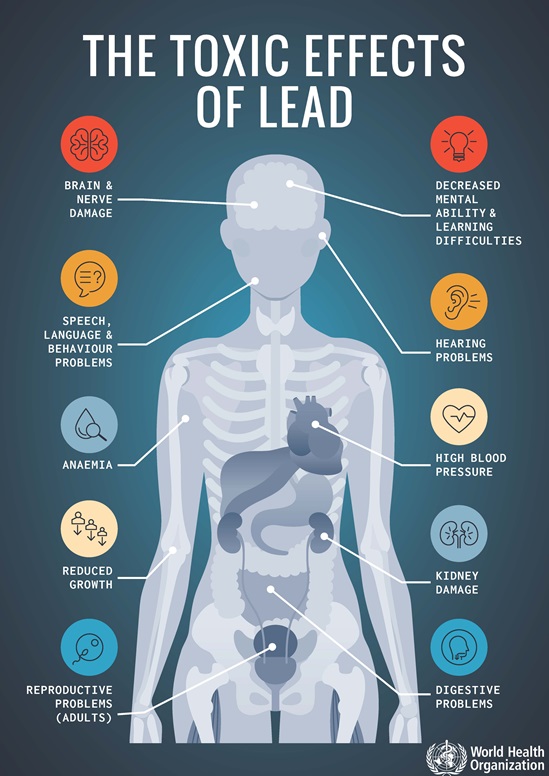
Children playing on swings at a playground. Playground equipment is often painted with lead paint. Deteriorating lead paint is a source of exposure to lead.
International Lead Poisoning Prevention Week
23-29 October 2022
About the campaign
The issue
Lead is a well-recognized toxicant that has wide-ranging health impacts, in particular affecting the neurological, cardiovascular, gastrointestinal and haematological systems. Young children are particularly vulnerable because they have higher exposures than adults and because lead affects the developing brain, potentially resulting in reduced intellectual ability. The World Health Organization (WHO) 2021 update of the “Public health impact of chemicals: knowns and unknowns” estimate that nearly half of the 2 million lives lost to known chemicals exposure in 2019 were due to lead exposure. Lead exposure is estimated to accounts for 21.7 million years lost to disability (disability-adjusted life years, or DALYs) worldwide due to long-term effects on health, with 30% of the global burden of idiopathic intellectual disability, 4,6% of the global burden of cardiovascular disease and 3.0% of the global burden of chronic kidney diseases.
Even though there is wide recognition of the harmful effects of lead and many countries have taken action, exposure to lead, particularly in childhood, remains of key concern to health care providers and public health officials worldwide.
Important sources of exposure to lead include environmental contamination from mining, smelting, manufacturing and recycling activities and the use of lead in a wide-range of products. More than three quarters of global lead consumption is for the manufacture of lead-acid batteries for motor vehicles. Other products containing lead include pigments, paints, solder, stained glass, lead crystal glassware, ammunition, ceramic glazes, jewellery, toys, some cosmetics such as kohl and sindoor and traditional medicines used in countries such as India, Mexico and Viet Nam. Drinking water delivered through lead pipes or pipes joined with lead solder may contain lead. Much of the lead in global commerce comes from recycling operations.Infographic on the toxic effect of lead
The campaign
International Lead Poisoning Prevention Week (ILPPW) takes place every year during the third week of October. 2022 will mark 10 years of action to eliminate lead paint. The focus of this year’s week “Say no to lead poisoning” recognizes the additional urgency of action needed to eliminate all sources of lead exposure.
The aim of the week of action is to:
- raise awareness about health effects of lead exposure;
- highlight the efforts of countries and partners to prevent lead exposure, particularly in children; and
- urge further action to eliminate lead paint through regulatory action at country level.
WHO Resource List

Policy background
WHO identifies lead as one of 10 chemicals of major public health concern needing action by Member States to protect the health of workers, children and women of reproductive age. Recent reductions in the use of lead in petrol, paint, plumbing and solder have resulted in a substantial reduction in population-level mean blood lead concentrations. However, significant sources of exposure still remain, particularly in developing countries.
Further efforts are required to continue to reduce the use and releases of lead and to reduce environmental and occupational exposures, particularly for children and women of child-bearing age. Interventions include eliminating non-essential uses of lead such as lead in paint, ensuring the safe recycling of lead-containing waste, educating the public about the importance of safe disposal of lead-acid batteries and computers. Measurement of blood lead levels in children, women of child-bearing age and workers can indicate the need for clinical intervention (see "Guideline for clinical management of exposure to lead").
Recognizing the continuing need for action to stop exposure to lead from paint, the second session of the International Conference on Chemicals Management (ICCM2) in 2009 nominated lead in paint as an emerging policy issue for voluntary cooperative action for risk reduction by countries under the Strategic Approach to International Chemicals Management (SAICM) policy framework. This led to the establishment of the Global Alliance to Eliminate Lead Paint (the Lead Paint Alliance) in 2011, under the joint leadership of the United Nations Environment Programme (UNEP) and the World Health Organization (WHO). The primary goal of the Alliance is to promote the global phase-out of lead paint through the establishment of appropriate legally binding measures to stop the manufacture, import, export, distribution, sale and use of lead paints in every country. WHO is also a partner in a project funded by the Global Environment Facility that aims to support at least 40 countries in enacting legally binding controls on lead paint. This goal has received further support in the WHO Chemicals Road map to enhance health sector engagement in the Strategic Approach to International Chemicals Management towards the 2020 goal and beyond (decision WHA70(23)), which includes national action to phase out the use of lead paint.
The elimination of lead paint will contribute to the achievement of the following Sustainable Development Goal targets:
3.9: by 2030 substantially reduce the number of deaths and illnesses from hazardous chemicals and air, water, and soil pollution and contamination;
12.4: by 2020, achieve the environmentally sound management of chemicals and all wastes throughout their life cycle, in accordance with agreed international frameworks, and significantly reduce their release to air, water and soil in order to minimize their adverse impacts on human health and the environment.
Publications
Exposure to lead: a major public health concern, 2nd edition
Lead poisoning from lead in paint is preventable and there are cost-effective, technically feasible alternatives to lead in paint. This toolkit is a collection...
Report on activities during the eighth International Lead Poisoning Prevention Week, 25-31 October 2020
The eighth International Lead Poisoning Prevention Week (ILPPW) was held on 25–31 October 2020, withmore than 90 events in 60 countries organized...
Exposure to lead: a major public health concern: preventing disease through healthy environments, 4th...
Lead is a toxic metal whose widespread use has caused extensive environmental contamination and health problems in many parts of the world. It is a cumulative...
The global status of legally binding controls on lead paint is regularly monitored and updated in the WHO Global Health Observatory. An annual report...
Exposure to lead: a major public health concern: preventing disease through healthy environments, 3rd...
Lead is a toxic metal whose widespread use has caused extensive environmental contamination and health problems in many parts of the world. It is a cumulative...
The World Health Organization International Lead Poisoning Prevention Week (ILPPW) campaign is held annually with the objectives of raising awareness...
The global status of legally binding controls on lead paint is regularly monitored and updated in the WHO Global Health Observatory.An annual report on...
Lead is a priority chemical hazard that should be included in national drinking-water quality standards and monitored as part of drinking-water quality...
The purpose of this addendum to the business plan of the Global Alliance to Eliminate Lead Paint (also known as the Lead Paint Alliance) is to extend...
The purpose of the WHO Guideline for clinical management of exposure to lead is to assist physicians in making decisions about the diagnosis and treatment...
Guideline for clinical management of exposure to lead
The purpose of the WHO Guideline for clinical management of exposure to lead is to assist physicians in making decisions about the diagnosis and treatment...
Lead poisoning from lead in paint is preventable and there are cost-effective, technically feasible alternatives to lead in paint. This toolkit is a collection...
Report on activities during the eighth International Lead Poisoning Prevention Week, 25-31 October 2020
The eighth International Lead Poisoning Prevention Week (ILPPW) was held on 25–31 October 2020, withmore than 90 events in 60 countries organized...
This document has been developed as part of a project to accelerate progress towards the establishment of legally binding controls on the manufacture,...
This document provides a brief overview of commonly used analytical methods for measuring the concentration of lead in blood. It is primarily aimed at...
Global elimination of lead paint: why and how countries should take action - Technical brief
This document has been developed for officials in government who have a role in regulating lead paint, to provide them with concise technical information on...
Global elimination of lead paint: why and how countries should take action - Policy brief
Lead has toxic effects on almost all body systems and is especially harmful for children and pregnant women. Lead paint is an avoidable source of...
This document provides a brief overview of analytical methods available for measuring lead in paint. It is primarily aimed at informing public health...
From 20 to 26 October 2019 the seventh International Lead Poisoning Prevention Week of action (ILPPW) took place in countries around the world. This report...
The fourth edition of the World Health Organization’s (WHO) Guidelines for drinking-water quality (GDWQ) builds on over 50 years of guidance by WHO...
Recycling used lead-acid batteries: health considerations
This document explains how recycling used lead-acid batteries can cause significant environmental contamination and human exposure to lead. It provides...
The manufacture of lead-acid batteries accounts for about 85% of the global demand for refined lead metal. Much of this demand is met by recycled lead...

